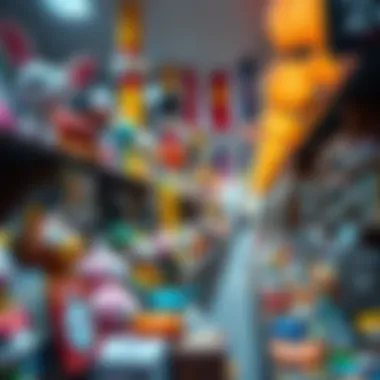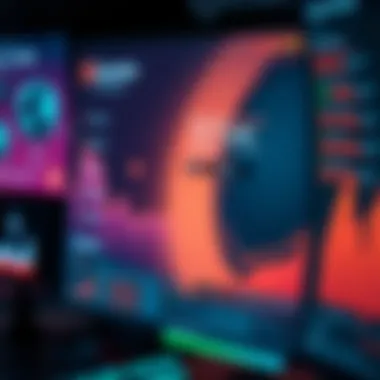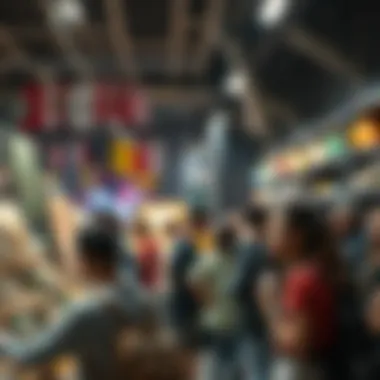Discovering Alternatives to OpenSea for NFTs


Intro
With the surge in popularity of digital art and collectibles, platforms such as OpenSea have found themselves at the forefront of the NFT boom. Yet, the NFT landscape is much broader than any single marketplace, presenting potential users with a variety of options that cater to specific needs and preferences. This article will take you on a journey through alternative platforms, scrutinizing their unique features and community dynamics while providing you with the knowledge to navigate this rapidly changing domain.
Key Concepts in Cryptocurrency
Understanding Blockchain Technology
It’s essential to grasp the underlying technology that powers NFTs—blockchain. It serves as a decentralized digital ledger, recording transactions in a secure manner. Think of it as a high-tech book where every transaction is inked and visible to everyone, ensuring transparency. Every time a digital asset is created, bought, or sold, it leaves a trace on the blockchain. This not only protects against fraud but also establishes provenance for digital artworks.
Blockchain’s immutable nature means that once something is written, it’s nearly impossible to change. For NFT platforms, this means that ownership can be easily verified without a middleman. Such a system is vital in the art community, helping to uphold the true value of creations.
The Role of Decentralization
Decentralization is at the heart of many blockchain technologies, creating an environment free from the control of a single entity. In the context of NFT marketplaces, this allows artists and collectors to interact directly without needing a centralized organization to mediate. Rather than relying on traditional galleries or auction houses, users can take control of their transactions.
However, with greater freedom comes more responsibility. Artists must ensure that they protect their intellectual property rights and understand the mechanisms of the platforms they utilize. It's a double-edged sword: empowerment paired with risk.
Investment Strategies and Market Trends
Analyzing Market Indicators
For those dipping their toes into the world of NFTs, understanding market indicators is crucial. Keep an eye on trading volumes, price fluctuations, and the general interest shown in specific types of assets. Platforms often provide stats to show how particular genres or artists are performing; this can offer valuable insights.
A few key indicators to track include:
- Overall sales volume (how much money is changing hands)
- Number of active wallets (indicating engagement levels)
- Price trends of notable artists or collections
Long-Term vs Short-Term Investment Approaches
Investing in NFTs can be likened to navigating a winding river. Some choose to launch right in, hoping for a quick profit, while others prefer to paddle slowly and seek out hidden gems. Deciding whether to invest long-term or to flip assets in the short term depends largely on individual goals and risk tolerance.
- Long-term approach: Buying and holding pieces you believe will appreciate in value over time. This method often requires a significant amount of research into the artist and market trends.
- Short-term approach: Hot assets that can be flipped quickly for profit, often leaning on trends or hype. This can be riskier, as trends can shift quickly.
As you venture through these platforms, remember the wisdom of caution—what seems hot today may cool off tomorrow. Make decisions based on research and your own comfort with risk.
"Navigating the NFT space requires both knowledge and intuition. Empower yourself with information to make wiser choices."
In closing, the world of alternative NFT platforms is as varied as the art it houses. Understanding the fundamentals of blockchain and the dynamics of decentralization equips you for this new digital age. Likewise, formulating a robust investment strategy tailored to your personal goals can aid in successfully navigating this exhilarating yet complex marketplace.
Preamble to NFT Marketplaces
The growth of digital art and collectibles has made non-fungible tokens, or NFTs, a hot topic across various sectors. NFT marketplaces serve as essential platforms where creators and collectors can engage in the buying, selling, and trading of these unique digital assets. Understanding NFT marketplaces is crucial not only for artists looking to find their audience but also for investors wanting to dive into this burgeoning landscape.
The essence of NFT marketplaces lies in their ability to connect creators with buyers while providing a structured environment for transactions. Here, users can track ownership, verify authenticity, and interact with a community of like-minded individuals. Besides, NFT marketplaces are not just about trade; they encapsulate a new era of digital ownership and creativity.
The significance of platforms like OpenSea cannot be overstated within this context. As one of the largest and most recognized marketplaces, it has paved the way for many others. However, the ecosystem is diversifying as more platforms enter the fray, each offering unique features and benefits. By delving into a broader array of NFT marketplaces, users can discover options that better suit their particular needs and preferences.
In this exploration, we will scrutinize the dimensions of NFT marketplaces, taking into account their definitions and overall purposes. Moreover, we will emphasize the critical role OpenSea plays in shaping the NFT community and what makes it stand out in the vast sea of digital trading environments.
Overview of OpenSea's Features
OpenSea has positioned itself at the forefront of the NFT marketplace due to its extensive feature set that caters to a diverse range of users. Understanding the various aspects of OpenSea is essential for anyone looking to navigate the vibrant world of digital assets. By enlightening readers about its user interface, supported asset types, and fee structure, this section grants insight into how OpenSea operates and what separates it from competitors.
User Interface and Access


The user interface of OpenSea plays a critical role in its popularity. The platform embraces simplicity and functionality, making it accessible for both novices and seasoned traders. When first landing on the homepage, users encounter a clean layout adorned with vibrant images of featured NFTs. The search function stands out, allowing users to swiftly locate specific assets or explore categories.
Users can easily create an account using a crypto wallet such as MetaMask, which streamlines the registration process. Accessibility is another plus; OpenSea caters to different time zones and even supports multiple languages, bridging gaps broadly for global users.
- Key Points:
- Intuitive design that prioritizes user experience.
- Seamless connection with various crypto wallets.
- Multi-language support catering to a global audience.
Supported Asset Types
OpenSea's broad array of supported asset types is one of its major selling points. The platform allows users to trade digital art, domains, virtual world items, and more. This diversity not only appeals to various collectors but also enables creators to think outside the box when minting NFTs. Some specific types include:
- Art: Unique digital artwork from artists worldwide.
- Music: Original tracks and albums digitized as NFTs.
- Domain Names: Digital real estate that serves as unique web addresses.
- Virtual Goods: Items within video games or virtual worlds, enhancing user experiences.
By permitting such a variety of assets, OpenSea attracts a community that spans multiple creative fields, fueling competition and innovation.
Fee Structure and Payment Options
Understanding OpenSea’s fee structure is crucial for financial planning in the NFT marketplace. OpenSea operates on a commission model, charging a fee of 2.5% on every transaction. While this may seem modest, buyers and sellers need to consider gas fees associated with Ethereum transactions, which can fluctuate considerably based on network congestion.
Moreover, OpenSea supports a range of cryptocurrencies, primarily Ethereum, but also includes support for others, such as DAI and USDC. This versatility allows users to transact comfortably within their preferred digital currency ecosystem. Here are some distinct aspects of its fee structure:
- Transaction Fees: Standard 2.5% on sales.
- Gas Fees: Variable fees based on network demand.
- Accepted Payments: Ethereum, USDC, and DAI supported for transactions.
Overall, the transparent nature of OpenSea's fee structure, along with various payment options, promotes a trustful environment for users. By offering a straightforward fee model, the platform encourages participation from investors looking to buy or sell NFTs without hidden surprises.
Exploring Alternatives to OpenSea
As the digital art and collectibles space continues to burgeon, the exploration of alternatives to OpenSea is paramount for anyone involved in the NFT scene. While OpenSea has its distinct advantages, other platforms cater to unique user preferences, allowing for a broader understanding of the NFT marketplace.
Rarible: A Community-Driven Marketplace
Rarible stands out primarily due to its community-driven ethos, giving users a stake in the platform's governance through its native token, RARI. This feature enriches user engagement as individuals can vote on key decisions that shape the marketplace. The platform allows users to create, buy, or sell digital assets effortlessly. Rarible has established itself as more than just a marketplace; it’s a vibrant community of artists and collectors fostering mutual recognition and support.
Foundation: Fostering Artist Collaboration
Foundation takes a different approach by focusing on artist collaboration. This platform curates a select group of creators, fostering an environment where emergent talent can thrive. It highlights the art rather than the marketplace itself. This makes Foundation appealing to collectors looking for rare pieces while ensuring artists receive due recognition. Therefore, this landscape transforms the experience from mere transactions into genuine partnerships between artists and collectors.
Mintable: User-Friendly NFT Creation
Mintable simplifies the creation of NFTs, making it accessible for users who may not possess extensive tech skills. Its intuitive interface allows for easy minting with just a few clicks. This ease of use promotes inclusivity, enabling a wider array of creators to participate in the NFT ecosystem. Whether you’re an artist or a business hoping to get into NFTs, Mintable can be a stepping stone into the digital art world.
Zora: Empowering Creators through Royalties
Zora distinguishes itself by emphasizing creator royalties, where artists can earn a percentage of future sales whenever their works are resold. This system empowers creators, ensuring they benefit financially from their work over time. The platform revolutionizes the traditional art world's concept by funding the artists directly and ensuring they maintain a lasting connection with their audience.
SuperRare: Curated Art Marketplace
SuperRare operates as a highly curated platform, showcasing top-tier digital artists. The selective nature of this marketplace attracts serious collectors who are looking for not just art, but investments with growth potential. Given its focus on quality, users are often willing to pay a premium for unique works that are verified and backed by the artists themselves.
Nifty Gateway: Limited Edition Drops
Nifty Gateway is notable for its limited edition drops, where creators release exclusive works at specific times, creating a buzz akin to ticket sales for popular events. This scarcity adds value and excitement to the buying process, ensuring that collectors are always on their toes. With integrations for fiat purchases, Nifty Gateway also makes it easier for newcomers to enter the NFT world.
WeEth: An Inclusive NFT Marketplace
Lastly, WeEth aims to provide an inclusive space for all users, breaking down barriers that often limit participation in the NFT community. Its user-friendly interface and lower fees appeal especially to those just starting their NFT journey. This platform serves as a reminder that the NFT marketplace can be inviting and not just exclusive.


In sum, the variety of platforms available beyond OpenSea caters to diverse user needs and preferences. Each brings something unique to the table, enriching the overall experience in this rapidly evolving market. Whether you're an artist, a collector, or simply interested in the technological advancements of NFTs, it's vital to explore these alternatives.
Comparative Analysis of Features
The growing NFT marketplace has drastically altered how digital art and collectibles are perceived, traded, and appreciated. While OpenSea has set a significant precedent, various alternatives deserve attention. A comparative analysis of the features across these platforms not only highlights their unique strengths but also equips potential users with essential insights to make informed decisions. This section aims to dive into particular elements crucial to understanding how different platforms operate and what benefits they provide.
User Experience Across Platforms
User experience, often referred to as UX, is paramount when examining NFT marketplaces. A streamlined and intuitive interface can make or break a user's ability to navigate a platform seamlessly. For instance, while OpenSea presents a familiar layout, platforms like Rarible emphasize community engagement through voting mechanisms, allowing users to have a say in platform developments.
Consider Foundation, where functionalities are designed to facilitate artist collaboration. The onboarding process is straightforward, which is essential for new users to quickly grasp how the platform works. In contrast, Nifty Gateway leverages a minimalistic design, focusing on ensuring a smooth transaction process.
Here are some aspects to consider regarding user experience:
- Navigation: Does the platform facilitate easy browsing?
- Sign-up Process: Is it simple or convoluted?
- User Feedback: How often do users cite frustration with a platform?
Platforms that prioritize user-centered design often achieve greater retention rates and satisfaction.
Diversity of Available Assets
One of the defining features of any NFT marketplace is the variety of assets it supports. For instance, OpenSea allows for a vast range of digital collectibles, art, domain names, and even virtual real estate. However, competitors like Mintable extend the asset realm by enabling users to create and sell not just art but also music, videos, and even moments captured in time.
Platforms can be classified based on the asset types they prioritize:
- Art-focused: SuperRare primarily focuses on genuine artistic endeavors, showcasing high-quality artworks.
- Community-driven creations: Rarible empowers users to mint and sell assets easily, fostering a community ecosystem.
- Limited editions: Nifty Gateway's drops offer a unique collector's appeal.
By examining the diversity of assets available, users can align their interests with a marketplace that resonates with their preferred types of digital treasures.
Fees and Charges: A Detailed Comparison
Understanding the fee structures across various platforms is essential for users contemplating which marketplace to engage with. OpenSea, for instance, has a flat fee for sales, but hidden costs can emerge based on the gas fees tied to Ethereum transactions. On the other hand, Rarible employs a more flexible model, allowing creators to set their own fees for royalties.
When evaluating fees, consider the following factors:
- Transaction Fees: What percentage cuts do platforms take on sales?
- Gas Fees: Given the volatile nature of Ethereum fees, do platforms optimize for lower costs?
- List and Minting Fees: Some platforms charge for listing or minting assets, significantly affecting overall profitability.
A comparison table might help highlight the distinct fee practices:
| Platform | Transaction Fee | Mint Fee | Royalties | | OpenSea | 2.5% | N/A | 10% (max) | | Rarible | 2.5% | N/A | Set by user| | Mintable | 2.5% | Depends | 10% (max) |
This clarity can direct user choices, especially for creators focused on maximizing their returns.
By evaluating user experience, diversity of available assets, and fee structures, potential users can paint a clear picture of which platform aligns best with their specific needs and aspirations. In the complex world of NFTs, such comparative analysis plays a crucial role in navigating the myriad options available.
Community and Support on NFT Platforms
The landscape of NFT marketplaces is as much about the community as it is about the assets traded. Community and support play significant roles in not only the featured offerings of each platform but also in shaping user experiences and interactions. When users browse for a platform to sell or purchase NFTs, their decision is often influenced by the vibrancy of the community behind it. Engaging communities can provide unique insights, guidance, and encouragement for both seasoned collectors and novices alike.
A strong support system fosters trust, which is crucial for investors who are putting their resources on the line. Consequently, understanding how platforms nurture their communities can aid prospective users in choosing a marketplace that aligns with their needs and values.
Engagement and Interaction Levels
Engagement levels within any NFT platform can greatly affect user satisfaction and perception. A platform that facilitates interaction encourages the cultivation of relationships, and as a result, establishes a sense of belonging among its users. Some platforms employ mechanisms, such as forums or integrated social media, to enhance engagement.
- Active Discussions: Platforms that host forums or Discord channels create spaces where users can discuss trends, share experiences, and seek advice. For example, Rarible utilizes its governance tokens to engage users in decisions about platform changes.
- Collaborative Events: Many marketplaces orchestrate events or competitions to boost interaction. These events can take the form of contests inviting users to showcase their NFTs, exchanging not only artwork but also feedback and creativity.
- Feedback Loops: Encouraging users to submit feedback can help create a responsive atmosphere. Users feel like their voices matter, guiding improvements and enhancing the overall experience.
These levels of engagement often help individuals forge connections, making the digital world feel more like a community.


Resources and Educational Initiatives
To truly empower users, platforms must prioritize educational resources that can help demystify the NFT landscape. Newcomers, especially, may feel overwhelmed when diving into this digital frontier without guidance. Accessible resources can level the playing field.
- Guided Tutorials: Some platforms provide easy-to-follow tutorials—think of them as digital roadmaps—for users to navigate that are invaluable for first-timers. These can cover everything from creating an NFT to effectively leveraging it for marketing.
- Webinars and Workshops: Scheduled educational sessions can deepen community ties while providing practical, hands-on experiences. Attending workshops not only broadens knowledge but also connects users with like-minded individuals.
- Knowledge Bases: Comprehensive FAQs and knowledge bases empower users to find answers on their own. Consider platforms like OpenSea, which has extensive documentation and user guides that cover basic and advanced topics.
In essence, the synthesis of community engagement and educational resources represents a vital part of the NFT ecosystem. A robust support network can illuminate the path for users, guiding them to harness the true potential of their digital assets.
Future Trends in NFT Marketplaces
As the adoption of digital assets continues to grow, understanding the trends shaping NFT marketplaces becomes crucial. These trends aren't just decorative toppings on the digital pie; they signify deeper shifts in how art, technology, and commerce intersect. Investors, educators, and analysts should pay keen attention not only to the current landscape but also to the projections that dictate its evolution!
Innovations in User Interface Design
User interface is the first handshake a user has with an NFT platform. A polished and intuitive layout can either invite users in or send them packing to the competition. Recent advancements have seen platforms doubling down on creating more user-centered designs that demystify the NFT buying process—transforming it from a challenge into a stroll in the park.
With platforms like Mintable and Rarible, the focus is on seamless interactions, where even tech novices feel empowered to create or purchase NFTs. Menus are simplified, and onboarding is streamlined. This means less jargon and more straightforward pathways to understanding wallets, listings, and sales.
Notably, the emergence of augmented reality elements in UI design is also gaining traction. Imagine viewing a piece of digital art in your living room through your smartphone before making a purchase—this is not merely a pipe dream, but rather a trend that's making waves in the marketplace.
Emergence of New Asset Types
The NFT scene is anything but stagnant. As we peer into the future, what’s becoming increasingly apparent is the diversification of asset offerings beyond traditional art and collectibles. New asset types are starting to sprout, ready to shake up the marketplace.
- Virtual Real Estate: Platforms like Decentraland are paving the way for NFTs as land parcels, where users can own and develop virtual spaces.
- Music and Audio: Musicians are turning to NFTs for releasing albums and securing new revenue streams, as platforms like Audius errect frameworks to facilitate this trend.
- Domain Names: It’s not just about capturing art; unique virtual domains are becoming sought after, representing investment opportunities in the ever-evolving digital landscape.
This shift demonstrates that NFTs are inching towards mainstream acceptance in various sectors. The sky seems to be the limit on where they are heading next!
Potential Regulatory Changes
As with many new technology trends, government scrutiny looms on the horizon of the NFT world. The potential for regulations impacts not just the platforms but also the investors and artists involved.
A main concern centers around rights management—how ownership of digital art is defined and tracked. If a piece of art is fractionalized through an NFT, who holds the copyright? Regulatory frameworks are, hopefully, being shaped to bring clarity and safety to this digital space.
Another aspect is taxation. Collecting taxes on NFT transactions is a complicated affair, and tax authorities are working to establish more precise guidelines. This will affect how investors report gains, fundamentally reshaping strategies around trading and collection.
Such regulations could also instigate a healthy evolution in the industry, fostering trust and legitimacy. Following regulations, serious players in the market can emerge, offering peace of mind to buyers wary of scams.
"Regulatory oversight may seem like a burden, but in the long run, it can nurture a more stable ecosystem with greater purpose and security."
In summary, the future of NFT marketplaces is a complex landscape filled with promise, potential, and questions. For investors and users alike, keeping an eye on these trends will guide sound decision-making as the markets mature.
Closure: Choosing the Right Platform
In the vast and ever-evolving landscape of NFT marketplaces, selecting the right platform requires not only awareness but also astute consideration. The right choice can enhance a user's experience, whether they are an artist, collector, or investor. Each platform brings its own flavor, benefits, and drawbacks, making it crucial for users to reflect on their specific needs and preferences.
Evaluating Your Needs as a User
Firstly, understanding one's own needs is pivotal. Collectors may prioritize access to rare assets and community engagement, while creators might focus on ease of minting and profitability. Ask yourself:
- What type of NFTs am I interested in?
- Am I more inclined towards digital art or collectibles?
- Do I prefer a platform that offers a variety of payment options or one that has a straightforward fee structure?
By answering these questions, users can align their goals with the right platform. For instance, avid collectors might find platforms like SuperRare appealing due to their curated collections, while artists who want to directly engage with their audience may lean towards Rarible or Mintable, where community interaction holds more weight.
Maintaining Awareness of Market Changes
The NFT marketplace is a space where changes happen faster than one can blink. New platforms may emerge, existing ones can evolve, and the socio-legal context surrounding NFTs is continuously shifting. Being aware of these fluctuations is imperative.
Regularly reviewing updates from trusted resources—like news outlets such as CoinDesk, forums like Reddit (r/NFT), or educational pages from platforms like Investopedia—can provide significant insights. Attending webinars, participating in NFT discussion groups, and following thought leaders on social can also yield valuable information.
"In this rapidly changing space, staying informed is half the battle; adaptability is the other half."
Ultimately, the decision lies with the user. More than just finding a platform that suits present needs, it is about finding a home that resonates with one’s artistic vision, community engagement, and investment strategy. As the NFT realm expands and transforms, a discerning approach will lead to better choices and a more rewarding experience.



